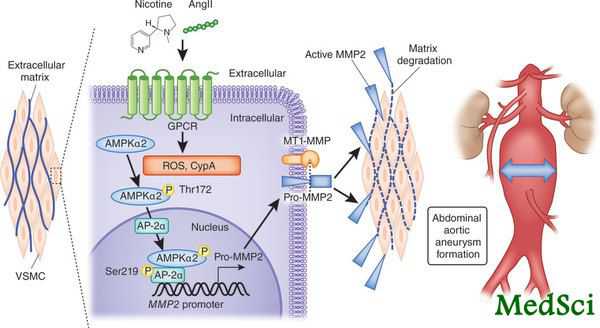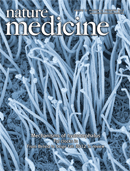
腹主动脉瘤(abdominal aortic aneurysm,AAA)是主动脉瘤最常见的形式。破裂的腹主动脉瘤是导致美国人口死亡的第13位因素。目前引起AAA的确切原因并不清楚。在所有可识别的风险因子中,吸烟能够增加患AAA 风险7.6倍,并且是唯一一个与AAA发展、扩张以及破裂相关的可改变因素。但是吸烟增加AAA的机制目前还不清楚。
AAAs的病理特征为动脉壁层膨胀,由弹性蛋白的缺失、平滑肌细胞的凋亡以及代偿胶原沉积导致。活性氧(Reactive oxygen species,ROS)被认为在炎症、基质降解与AAA的发病机理中起着桥梁作用。虽然在AAA中ROS的量会增加,但ROS引起AAA的分子机制目前并不清楚。
AMPK是一种丝氨酸/苏氨酸激酶,由α、β 和 γ三个亚基组成。α亚基为催化亚基,有两种形式:AMPK-α1 和AMPK-α2,β 和 γ亚基为调节亚基。AMPK是机制能量的监测者,对身体的能量代谢起着调节作用。有研究表明,氧化剂或者缺氧条件能够激活AMPK。目前,氧化剂介导的AMPK的激活能够抑制血管平滑肌细胞的增殖以及血管紧张素II(angiotensin II,AngII)引起的血管再狭窄。但是AMPK是否参与到AAA的形成目前并不清楚。
最近,美国俄克拉荷马大学医学院健康科学中心的Shuangxi Wang发现了吸烟与患AAA之间的因果联系。给载脂蛋白(apolipoprotein E,apoE)敲除小鼠 (Apoe-/-)或者apoE、AMPK-α1双基因敲除(Apoe-/-;Prkaa1-/-)小鼠急性输注AngII或者尼古丁都可以显著增加其患AAA的几率。相反,AMPK-α2的缺失能够降低AngII或尼古丁诱导的AAA。在机制研究方面,他们发现尼古丁和AngII都能激活血管平滑肌细胞中的AMPK-α2,从而导致激活蛋白2α(activator protein 2α,AP-2α)的磷酸化,最终增加基质金属蛋白酶2 (matrix metallopeptidase 2,MMP2)基因的表达。
该研究揭示,吸烟主要是通过增加AMPK-α2介导的依赖于AP-2α的MMP2表达从而增加AAA风险。

Abdominal aortic aneurysm is an enlargement of the abdominal aorta that represents a difficult clinical problem because the initial symptom is often rupture of the aneurysm1, an event with a mortality exceeding 70% (ref. 2), despite advances in surgical treatment3. These aneurysms start as small dilatations of the abdominal aorta that gradually expand over the course of years with the risk of rupture increasing drastically once the aneurysm reaches a diameter of 5 cm or more. The only accepted treatment for these large aneurysms is surgical open or endovascular graft placement. Early detection of smaller abdominal aneurysms is important because it enables clinicians to observe aneurysm expansion and intervene before rupture. However, prophylactic surgery for aneurysms smaller than 5 cm has not proven useful, so the current practice is watchful waiting until intervention is possible, and most aneurysms slowly expand over years.
Epidemiologic data have clearly linked tobacco smoking to aneurysm formation and a faster rate of expansion1, 4. Pathological examination of human abdominal aortic aneurysm tissue has shown that it is characterized by intense oxidative stress, inflammation and matrix degradation5, 6, but the mechanistic relationship linking aneurysm formation to smoking has remained elusive.
In this issue of Nature Medicine, Wang et al.7 break this impasse and provide new insights into the link between tobacco smoking and abdominal aortic aneurysms (Fig. 1). Using mouse models, they found that nicotine, the main dependence-forming ingredient of tobacco, increases aneurysm formation by stimulating the α2 isoform of AMP-activated protein kinase (AMPKα2) in vascular smooth muscle cells (VSMCs). Activation of AMPKα2, in turn, resulted in phosphorylation of activator protein 2α, a transcription factor that drives the expression of and smooth muscle cell release of matrix metalloproteinase 2, a matrix-degrading protein that functions to weaken the artery wall, thus facilitating aneurysm formation8.
来源:手牵手博客 贺利军
版权声明:
本网站所有注明“来源:梅斯医学”或“来源:MedSci原创”的文字、图片和音视频资料,版权均属于梅斯医学所有,非经授权,任何媒体、网站或个人不得转载,授权转载时须注明“来源:梅斯医学”。本网所有转载文章系出于传递更多信息之目的,且明确注明来源和作者,不希望被转载的媒体或个人可与我们联系,我们将立即进行删除处理。同时转载内容不代表本站立场。
在此留言
